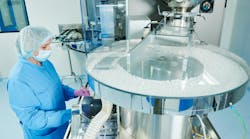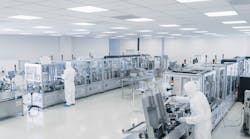The pharma market is undergoing rapid change, thanks to a strong pipeline in diabetes, weight loss and oncology treatments and the emergence of personalized medicine. To deliver these treatments and therapies, biopharma companies need a high level of predictability and agility in capital investments. In parallel, they must also optimize manufacturing to ensure that potentially transformative medicines get to patients, faster.
Solutions providers are responding to the challenge of delivering projects that adhere to cost and delivery schedules while meeting the highest safety standards. Moreover, to adapt to the dynamic marketplace and to meet shifting manufacturing needs, new facilities need to provide a high degree of flexibility.
These ‘facilities of the future’ have additional requirements. From a people perspective, they need to provide human-centric spaces where employees can work collaboratively and feel supported and empowered to fulfill their potential. The facilities must also operate and manufacture in a sustainable manner.
To deliver on these requirements, and to power the biopharma industry’s progress over the coming years, solutions providers are responding with an emerging project delivery concept — universal design.
The universal design concept
Universal design is a best-practice approach that leverages data to provide holistic solutions for operational, people and sustainability challenges. Data and digital tools play a key role in implementing this concept during the project design and delivery phases. They are also crucial when a facility is in operation.
In the design phase, deploying a replicable, modular digital framework means a single facility design can be leveraged and deployed across multiple sites. This approach offers the potential to achieve considerable cost savings and drive consistency across facilities in geographically dispersed sites.
Under the universal design concept, automation is deployed during the operational phase to optimize manufacturing. Automation comes into its own when operations have a heavy manual focus.
For example, production of personalized medicine requires that each individual dose is handled manually. Typically, a cell therapy facility will be equipped with multiple workstations, each with a dedicated operator. Leveraging data and automation to enable a smart manufacturing approach — which seamlessly blends innovation in AI and automation — provides the potential to streamline this work and support scale up rather than scale out, with the ultimate objective of providing faster access to medicine. A shift to single-use operations and continuous processing are other possible examples.
The role of smart manufacturing
With the industry requiring greater agility, there will be a focus on improving and streamlining change management processes, with data and smart manufacturing capabilities playing increasingly important roles, delivering greater flexibility, utilization and efficiencies.
Smart manufacturing, coupled with data collection and analysis, is also important when it comes to implementing energy savings so facilities operate in a more sustainable manner. In this regard, the pharma industry can leverage AI-led sustainability approaches deployed in other sectors.
For example, AI-enabled monitoring and control systems are used in wastewater treatment plants to automatically monitor and adjust aeration equipment, leading to significant energy savings. These digital tools can be deployed to do real-time environment monitoring in pharma facilities. They can play a vital role in optimizing energy efficiency, while also increasing output.
Cleanrooms must be validated to protect the product. Deploying smart manufacturing tools provides the potential for people to spend less time in clean rooms, allowing intelligent monitoring and real-time decision-making to optimize the conditions.
In conventional batch pharma manufacturing, a significant portion of facility time is spent in set-up and cleaning operations. Smart manufacturing capabilities will reduce cycle times, resulting in considerable energy savings. It means facilities can reduce overall energy/utility consumption and increase their yield.
Future-proofing workspaces
From a people perspective, universal design ushers in a new way of thinking when it comes to delivering life sciences facilities. Effectively, it is led by a human-centric approach that responds to employees’ needs while supporting the evolving nature of the workplace.
When planning a facility, the conventional design approach assumes the workforce comprises 50% men and 50% women. This model does not take account of shifting demographics, which means a facility may need to be upgraded to accommodate the make-up of a future workforce. Such upgrades can be disruptive and costly.
In contrast, universal design is based on the premise that workspaces should be designed for a wide variety of needs. At the heart of this approach is the integration of shared spaces and facilities — including toilets, lockers and changing rooms and workspaces — into the overall design concept.
This approach means the entire workforce is supported and that facilities are futureproofed to support shifting workplace demographics. The use of shared spaces under the universal design model delivers sustainable, cost-effective outcomes for biopharma companies.
Setting a new benchmark for facilities
As the pharma sector continues to focus on emerging lifesaving therapies, solutions providers are responding with a holistic approach that delivers ‘facilities of the future’ on schedule, within budget and with optimized manufacturing.
Powered by data and smart manufacturing, universal design means these ‘facilities of the future’ operate in a sustainable manner. This emerging approach also delivers human-centric spaces that meet the needs of shifting demographics, ensuring a diverse workforce can fulfill its potential.
Ultimately, this seismic shift in thinking represents industry best practice and sets a new benchmark for facility design and delivery. It also meets the most important metric — delivering potentially transformative medicines to patients worldwide.






